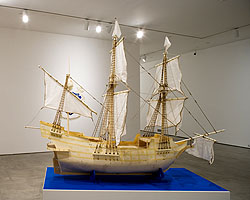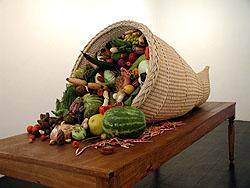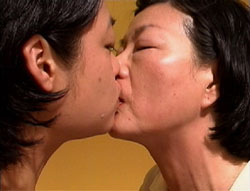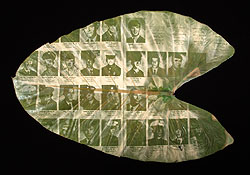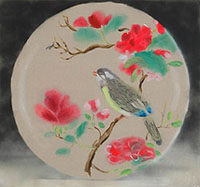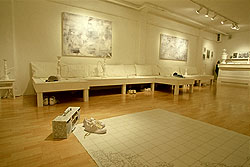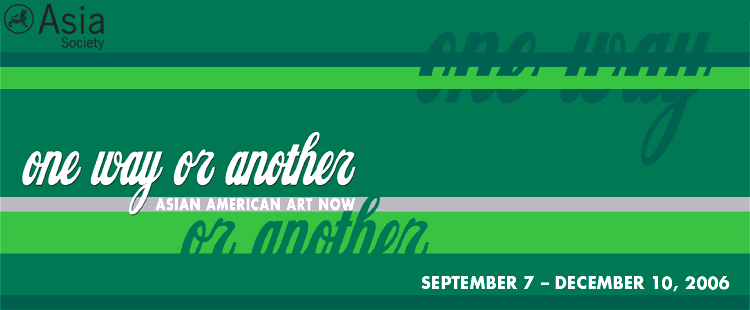 |
ARTISTS IN THE EXHIBITION Michael Arcega | Xavier Cha | Patty Chang | Binh Danh | Mari Eastman | Ala Ebtekar | Chitra Ganesh | Glenn Kaino | Geraldine Lau | Jiha Moon | Laurel Nakadate | Kaz Oshiro | Anna Sew Hoy | Jean Shin | Indigo Som | Mika Tajima | Saira Wasim |
|
Michael Arcega’s installations reflect his interest in visual and linguistic interaction, conflict and play. For One Way or Another, he produced Eternal Salivation, a wooden ark containing strips of jerky made from various animal meats. The relationship between “salivation” and “salvation” is key to understanding Arcega’s ironic commentary on human, animal, and cultural preservation in both historical and contemporary terms. As in his earlier work, El Conquistadork, Arcega’s motivation for these boat installations stem from his interest in the introduction of Christianity in the Philipines through Spanish colonists in the 16 th century. His ark in Eternal Salivation references the popular story of Noah’s Ark and playfully questions the fate of the Ark’s menagerie and their destinies as objects of “salvation” or “salivation”. Excerpt from artist’s statement [The story of Noah’s Ark] “…provides justification for the Christians’ and other Bible-based religions’ assumed right of domination. Speaking to Noah and his kin, God says: 'Be fruitful and increase in number and fill the earth. The fear and dread of you will fall upon all the beasts of the earth and all the birds of the air, upon every creature that moves along the ground, and upon all the fish in the sea; they are given into your hands. Everything that lives and moves will be food for you. Just as I gave you the green plants, I now give you everything.' (from the new international version of the Old Testament) This quote functions much like Manifest Destiny did for the United States as a doctrine that served as a driving force to go from “sea to shining sea” and conquer everything in between regardless of who or what existed there before. In the era of global warming, devastating hurricanes, and tsunamis, the icon of Noah’s Ark has a more current and complicated symbolism. We are confronted by disasters all over the globe with seemingly inadequate rescue efforts. As in the FEMA/Katrina tragedy, the poor and infirmed are left to their own demise. These questions arise: Who is worthy of saving and who is left to drown? Who will inherit the earth? Who decides?”
|
|
|
On the opening night of One Way or Another, Xavier Cha performed Horn of Plenty, part 1 of her Holiday Cruise! series, in which she assumed the identity of this overstuffed cornucopia. Cha is concerned with combining performance, sculpture, costume design, and installation in unconventional ways that challenge the boundaries between art, artist, and audience. In Horn of Plenty, Cha totally immerses herself in her performative personae, to the extent that her own identity is subsumed. The cornucopia basket of vegetables conceptually and literally swallows Cha whole, producing her as an actual work of art, fit for the eyes of an art-consuming public. Excerpt from artist’s statement “Central to Holiday Cruise! was an interest in how specific communities form and gather, and the intersections of these divergent and esoteric interests. The double entendre of “cruise” as an encapsulated journey on a vessel, and the desperate search for others to connect within a fleeting yet impassioned way informed the title of the project all within the celebratory nature of holidays.”
|
|
|
Patty Chang’s intriguing performance-based video works are composed somewhere between illusion and reality and are concerned with challenging the limits of socially acceptable behavior. For instance, In Love, a video from 2001, appeared to feature the artist emotionally kissing an older man and woman, but in actuality documented the artist and her parents consuming a raw onion. This unsettling, and humorous, element to Chang’s work can also be found in her current video, A Chinoiserie Out of the Old West (2006) produced for One Way or Another. Chang’s work is known for its overt physicality and its use of altered perception over “truth”. Excerpt from artist’s statement “A Chinoiserie Out of the Old West is a translation of the magazine article written by Walter Benjamin about Anna May Wong. In his essay “The Task of the Translator” (1923), Benjamin says, ‘. . . translation does not find itself in the center of the language forest but on the outside facing the wooded ridge; it calls into it without entering, aiming at that single spot where the echo is able to give, in its own language, the reverberation of the work in the alien one.’
|
|
|
Binh Danh is intrigued with the concept of historical time: who writes history?; who are its players?; and who are its readers? How does history map our identities and construct our immediate environments? These are some of the issues raised by Danh’s One Week’s Dead #1, part of a series of work that includes images from the June 27 th 1967 issue of Life Magazine entitled, “The Faces of the American Dead in Vietnam: One Week’s Toll”. Using the process of photosynthesis, he printed images from this article onto leaves. An immigrant to the United States from Vietnam at the age of two, Danh’s work often explores his personal histories with both the United States and Vietnam. In this series, the historical images of war live both inside and outside of the natural environment. The leaves express the continuity of war in Vietnam in their containment of its residue such as bombs, blood, sweat, tears, and metal. From this perspective, natural matter is neither created nor destroyed, but only transformed; the remnants of the Vietnam and American war live on forever in the Vietnamese landscape, or camouflaged in the jungle. Excerpt from artist’s statement “In a war-torn jungle, memories survive. They bleed into the soil and seep into the roots of plants. The plants reflect these spirits into corporeal forms. What you see here are the faces of the American dead in Vietnam during the week of May 28 to June 3, 1969… Using the process of photosynthesis, I printed these portraits onto leaves so you can imagine what death might look like when the body decays and the memories remain. How does the jungle tell what it witnesses? How do the spirits remain, camouflaged in the jungle?”
|
|
|
Mari Eastman’s dream-like scenes have often been described as possessing “sophisticated adolescence” or constructed “girlishness.” Her use of glitter, pastel washes, and airbrushing accentuates both the beautiful and the banal aspects of romantic daydreams and luxury fetishes. Bird on Flowering Spray: Porcelain Cup plays with a mass-produced motif of traditional Chinese painting that functions in the west as a sign of Chinese culture that is replicated endlessly on cheap popular goods. Eastman bases some of the images in her work on magazine photos, newspapers, calendars, and Time-Life books. The projection of sumptuous images may in fact question the comfortable and seductive quality of these scenes, exposing them as empty, and ultimately as a camouflage for reality and the mundane. Excerpt from artist’s statement “I work from a variety of sources culled from magazines, newspapers, books, personal photos, as well as paintings, fabric patterns, and illustrations. My work is representational. I like portraits of animals, decorative art, and landscapes. I like to mix it up, from a combination of restlessness and a desire for equilibrium.”
|
|
|
Ala Ebtekar’s installation Elemental is a tableau dedicated to the merging and blurring of cultural traditions from traditional Iranian society and contemporary popular music from the U.S. Ebtekar was born and grew up in Berkeley, California but traveled to Iran – his parent’s homeland – at the end of the 1990s. In Iran, he was immediately attracted to the historical practice of coffee house painting. This was traditionally a space where the dialogue, poetry, and stories told by common people were translated onto painting boards and coffee house walls by local artists. As a form of art that came organically from the desires of the common public, Ebtekar recognized an affinity with hip-hop culture and graffiti artists, movements with which he was more familiar. In Elemental, he imagines a hybridized space outside of time, where these cultural traditions can intersect on equal terms and blend narration and rhythm with visual and physical expression. While the architectural space represents an Iranian coffee house, the wall paintings, boom boxes, and clothing all reference popular American visual forms converging with Persian motifs to create a zone of suspended time and geography. He conjures the ideal forum for creative collaboration. What types of artistic interactions might occur in this space? Excerpt from artist’s statement “By merging influences, a visual atmosphere is presented that imagines the confluence of hip-hop culture within the physical and architectural space of a traditional Iranian coffee house. In effect, I articulate a moment in time where the past and the present collide. Here the audience is invited to envision and experience the many types of interactions that could happen in this hybridized place, amongst MCs and coffee house narrators, graffiti artists and coffee house painters, b-boys and wrestlers, DJs and drummers.”
|
|
| © 2005 Asia Society | 725 Park Avenue at 70th Street NY, NY 10021 | 212-288-6400 | Press Releases | Contact | FAQ | Become a Member
|
